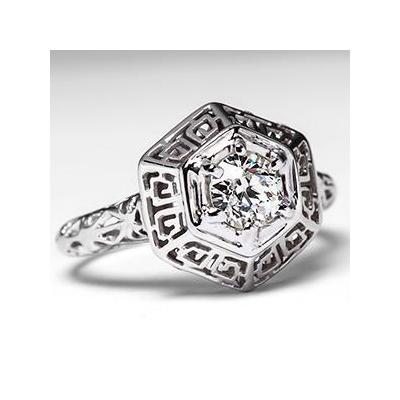
Posted in: Jewelry History
 Copyright 2013 EraGem
The setting of this ring is a study in contrasts. When viewed from the side, the intricate filigree decadent images from the previous Edwardian Period. However, when viewed from above, the brilliant Old Euro cut diamond is surrounded by a geometric engraving which elicits scenes from Ancient Greece or Rome.
Called the 'Greek Key' pattern by modern-day designers, this angular carving is an example of one of several characteristic motifs (e.g. Chevron, Spiral Scroll, and Concentric Circles) of Art Deco jewelry. A cursory glance at the historical record might lead one to believe that these styles find their origins in classical Greek form. However, a more thorough study indicates that, while the Greeks may have introduced these devices to the Western world in previous centuries, they were not the primary influences for their use in the Art Deco movement.
William Henry Goodyear, writing in 1893, calls the Greek Key design the 'Meander' and purports that it evolved, not from the meandering rivers of Turkey and Greece from which it derives its name, but from the prominent symbol of Ancient Egypt, the lotus flower. His arguments are compelling in their suggestion that the Greeks adopted all of these patterns from their study of Egyptian artifacts and tombs, many of which feature the Meander pattern. Among Goodyear's most compelling evidence is the presence of this key-like motif in the 13th-Dynasty tomb of Meri-ka-ra at Siout {The Grammar of the Lotus, 1893, p. 96}.
More recent sources may provide evidence that champions of the Art Deco movement would have bypassed the Greeks altogether, drawing directly from Egyptian artifacts for inspiration. Nancy Solomon suggests that classicism was out, while decadence combined with a renewed hope in the wonders of technology were in. She cites as evidence the discovery of King Tutankhamen's tomb in 1922 and the 1925 Exposition des Arts Decoratifs in Paris, from which Art Deco would eventually derive its name.
While the Exposition "captured the spirit of the times, amalgamating individual freedom of expression with a machine aesthetic," the archaeological breakthrough "whetted the public's appetite for the exotic" and also "influenced the organizers of the exposition" {Architecture, 2008, p. 43}.
Inspired by the sights of this grand exhibition, as well as the sleek lines of airplanes, automobiles, and trains of the 1920s, the architects of the day went on to design their buildings in like fashion, with symmetrical curves connected by geometric lines. Later, it was these at once sensuous and rigid buildings which inspired stunning Art Deco jewelry like this engagement ring with its, shall we say, Meandering motif.
Copyright 2013 EraGem
The setting of this ring is a study in contrasts. When viewed from the side, the intricate filigree decadent images from the previous Edwardian Period. However, when viewed from above, the brilliant Old Euro cut diamond is surrounded by a geometric engraving which elicits scenes from Ancient Greece or Rome.
Called the 'Greek Key' pattern by modern-day designers, this angular carving is an example of one of several characteristic motifs (e.g. Chevron, Spiral Scroll, and Concentric Circles) of Art Deco jewelry. A cursory glance at the historical record might lead one to believe that these styles find their origins in classical Greek form. However, a more thorough study indicates that, while the Greeks may have introduced these devices to the Western world in previous centuries, they were not the primary influences for their use in the Art Deco movement.
William Henry Goodyear, writing in 1893, calls the Greek Key design the 'Meander' and purports that it evolved, not from the meandering rivers of Turkey and Greece from which it derives its name, but from the prominent symbol of Ancient Egypt, the lotus flower. His arguments are compelling in their suggestion that the Greeks adopted all of these patterns from their study of Egyptian artifacts and tombs, many of which feature the Meander pattern. Among Goodyear's most compelling evidence is the presence of this key-like motif in the 13th-Dynasty tomb of Meri-ka-ra at Siout {The Grammar of the Lotus, 1893, p. 96}.
More recent sources may provide evidence that champions of the Art Deco movement would have bypassed the Greeks altogether, drawing directly from Egyptian artifacts for inspiration. Nancy Solomon suggests that classicism was out, while decadence combined with a renewed hope in the wonders of technology were in. She cites as evidence the discovery of King Tutankhamen's tomb in 1922 and the 1925 Exposition des Arts Decoratifs in Paris, from which Art Deco would eventually derive its name.
While the Exposition "captured the spirit of the times, amalgamating individual freedom of expression with a machine aesthetic," the archaeological breakthrough "whetted the public's appetite for the exotic" and also "influenced the organizers of the exposition" {Architecture, 2008, p. 43}.
Inspired by the sights of this grand exhibition, as well as the sleek lines of airplanes, automobiles, and trains of the 1920s, the architects of the day went on to design their buildings in like fashion, with symmetrical curves connected by geometric lines. Later, it was these at once sensuous and rigid buildings which inspired stunning Art Deco jewelry like this engagement ring with its, shall we say, Meandering motif. 11 years ago
11 view(s) 